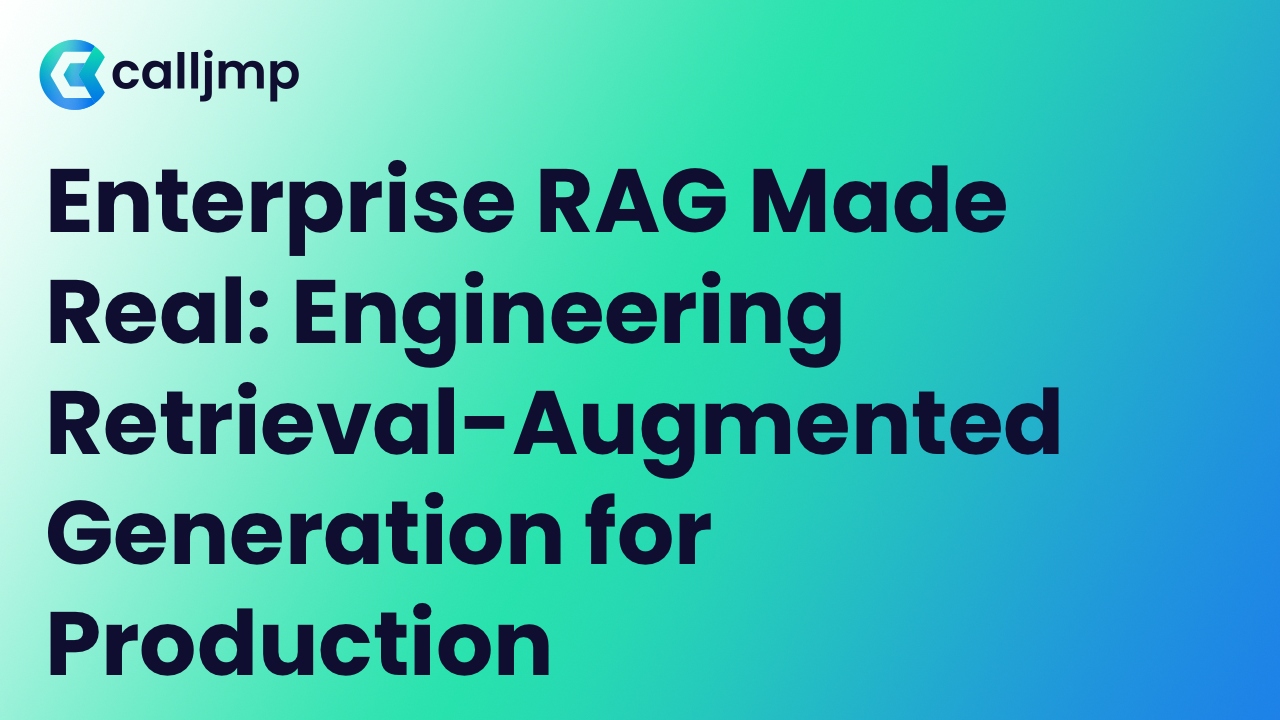Enterprise RAG Made Real: Engineering Retrieval-Augmented Generation for Production
Discover how to build production-ready enterprise RAG systems — with clean data pipelines, metadata models and agent workflows — as a developer using Calljmp.

Introduction
In today’s AI-driven world, the term enterprise RAG (Retrieval-Augmented Generation) shows up everywhere.
Enterprise product managers, tech founders, and engineering leads are asking: how can we scale RAG beyond prototypes, into real systems that solve business problems?
Most tutorials make it sound simple: “Just chunk your documents, embed them, feed a large language model (LLM), done.”
In practice, though, enterprise environments bring complexity: messy legacy data, regulatory constraints, domain-specific acronyms, huge tables, and fragmented knowledge sources. Without addressing these engineering realities, RAG projects stall or fail.
In this article, you’ll learn the core concepts behind retrieval-augmented generation for enterprises, the common pitfalls teams face, and how you can use Calljmp’s AI agents as code orchestration platform to build, deploy, and scale RAG solutions.
By the end, you’ll walk away with actionable insights you can apply in your technical roadmap.
1. What Is Enterprise RAG?
At its core, RAG means “retrieve relevant context, then generate output using that context.”
Unlike standalone LLMs that rely solely on pre-training, RAG augments the model’s responses with real-time or domain-specific data.
For an enterprise, this means building a pipeline that:
- Ingests documents from varied sources (PDFs, wikis, logs, databases)
- Processes them (cleaning, chunking, metadata tagging, embedding)
- Stores and indexes for fast retrieval (vector store, hybrid search)
- Routes queries via an AI agent or workflow that retrieves relevant context, passes it to the model, and returns an answer
Analogy: imagine your AI agent as a librarian. It fetches relevant books, highlights key paragraphs, and then writes a summary that quotes those passages. Without retrieval, you’re relying on memory alone.
2. Common Challenges in Enterprise RAG
Document Quality and Structure
Enterprises operate on decades of legacy data: scanned reports, inconsistent OCR, massive tables hidden in PDFs.
Without a document-quality scoring pipeline, you risk embedding noise and building a semantic search engine for chaos.
Naive Chunking and Context Loss
Many teams default to “512-token chunks.” But enterprise documents aren’t uniform — they contain abstracts, tables, and appendices.
Blind chunking destroys context. Structure-aware segmentation preserves meaning and improves retrieval accuracy.
Metadata Design: The Missing Link
Embeddings describe statistical proximity, not real-world relationships.
In pharma, “CAR” could mean Chimeric Antigen Receptor or Cardiac Assessment Report.
Without metadata (e.g., trial phase, compound, patient group), your RAG system can’t tell the difference.
In finance, metadata such as quarter, region, and segment enables precise retrieval like:
“Compare EMEA segment revenue in Q2 vs Q3.”
Without it, every “revenue” mention looks identical.
At Calljmp, metadata isn’t an afterthought. Developers define schemas directly in code, and the platform enriches and stores this context automatically.
Retrieval Strategy Gaps
Semantic search alone fails on acronyms, tables, and numeric queries.
Enterprises report 15–20% failure rates using embeddings only.
A robust system uses hybrid retrieval — embeddings + keywords + rules + graphs — to reach production-grade reliability.
Infrastructure and Governance
Proof-of-concept notebooks don’t scale.
Enterprises face GPU queueing, on-prem vs cloud trade-offs, storage costs, and compliance demands.
What matters is availability, control, and performance, not buzzwords.
3. How Calljmp Solves Enterprise RAG
At Calljmp, we’ve built a Cloudflare-native backend and AI orchestration platform where developers build and run AI agents and workflows as code in TypeScript for mobile and web apps.
Here’s how it helps you build production-ready enterprise RAG:
-
AI Agents as Code — In-App or CLI:
Define retrieval workflows, metadata schemas, and logic directly in TypeScript. Deploy them instantly from your IDE or via CLI.
-
Backend Included:
No need to maintain separate vector databases, message queues, or orchestrators. Calljmp provides the backend out of the box.
-
Hybrid Search by Design:
Combine metadata, embeddings, and rule-based retrieval natively.
-
Edge-Native Execution:
Calljmp runs globally on Cloudflare’s edge network — zero cold starts, low latency, and automatic scaling.
-
Build Once, Deploy Globally:
Write your agent once, deploy to mobile, web, or standalone CLI. Replace scattered AI tools with one platform that handles orchestration and infrastructure.
In short: stop gluing tools together. Calljmp gives you a complete AI runtime engineered for enterprise reliability.
Turn your AI workflows into real products
Go beyond prototypes — deploy your AI agents and RAG pipelines directly from TypeScript with instant Cloudflare edge execution.
4. Future Trends and Insights
The next generation of enterprise RAG will focus on:
- Agent-Based RAG Architectures: Real-time AI agents fetching fresh context at runtime instead of relying solely on static embeddings.
- Table- and Numeric-Aware Retrieval: Parsing and embedding tables as structured entities for more accurate numerical reasoning.
- Multimodal Context: Integrating text, images, and graphs for richer retrieval.
- Auditability and Governance: Enterprises will demand full traceability — which docs were used, how they influenced outputs, and who accessed results.
- Edge-Deployed Workflows: As mobile AI grows, edge-native RAG becomes critical for latency, compliance, and cost efficiency.
Calljmp is already aligned with this future — making agentic RAG a first-class capability.
Conclusion
Enterprise RAG isn’t magic — it’s hardcore engineering. Failures happen not because of weak models, but because of missing metadata, poor retrieval strategy, and fragile infrastructure.
With Calljmp, developers skip that complexity:
- Build AI agents as code in TypeScript
- Use a Cloudflare-native backend
- Orchestrate hybrid RAG pipelines with zero setup
- Deploy globally, instantly
Unify your AI stack with a single platform
Replace scattered RAG tools and glue code. Build



